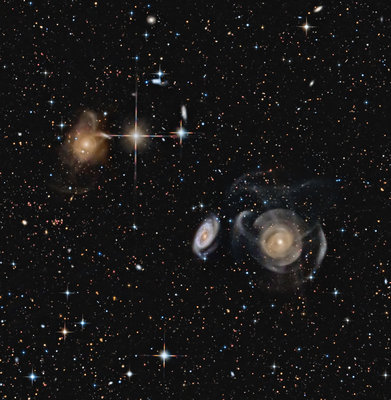by KuriousGeorge » Tue May 28, 2019 2:58 pm
NGC 467, 470 & 474. KG Observatory, Julian CA.
Imaging telescope or lens:Planewave CDK24
Imaging camera:FLI Proline 16803
Mount:Planewave L600
Guiding camera:Starlight Xpress Ultrastar
Focal reducer:None
Software:PHD Guiding 2, PixInsight 1.8, Planewave PWI4, Planewave PWI3, Maxim DL6, Neat Image V7, Photoshop CS3, Sequence Generator Pro
Filters:Astrodon 50mm B, Astrodon 50mm R, Astrodon 50 mm G, Astrodon 50mm L
Accessories:FLI CFW-5-7, Astrodon Monster MOAG, Hedrick Focuser, Planewave Delta-T, Planewave EFA
Resolution: 3620x3708
Dates:Nov. 1, 2018, Nov. 5, 2018, Nov. 6, 2018, Nov. 7, 2018
Frames:
Astrodon 50 mm G: 13x900" -20C bin 1x1
Astrodon 50mm B: 16x900" -20C bin 1x1
Astrodon 50mm L: 40x900" -20C bin 1x1
Astrodon 50mm R: 15x900" -20C bin 1x1
Integration: 21.0 hours
Darks: ~20
Flats: ~80
Flat darks: ~80
Bias: ~20
Avg. Moon age: 27.00 days
Avg. Moon phase: 12.03%
Mean SQM: 21.40
Locations: KG Observatory, Julian, CA, United States
- Attachments
-

NGC 467, 470 & 474. KG Observatory, Julian CA.
Imaging telescope or lens:Planewave CDK24
Imaging camera:FLI Proline 16803
Mount:Planewave L600
Guiding camera:Starlight Xpress Ultrastar
Focal reducer:None
Software:PHD Guiding 2, PixInsight 1.8, Planewave PWI4, Planewave PWI3, Maxim DL6, Neat Image V7, Photoshop CS3, Sequence Generator Pro
Filters:Astrodon 50mm B, Astrodon 50mm R, Astrodon 50 mm G, Astrodon 50mm L
Accessories:FLI CFW-5-7, Astrodon Monster MOAG, Hedrick Focuser, Planewave Delta-T, Planewave EFA
Resolution: 3620x3708
Dates:Nov. 1, 2018, Nov. 5, 2018, Nov. 6, 2018, Nov. 7, 2018
Frames:
Astrodon 50 mm G: 13x900" -20C bin 1x1
Astrodon 50mm B: 16x900" -20C bin 1x1
Astrodon 50mm L: 40x900" -20C bin 1x1
Astrodon 50mm R: 15x900" -20C bin 1x1
Integration: 21.0 hours
Darks: ~20
Flats: ~80
Flat darks: ~80
Bias: ~20
Avg. Moon age: 27.00 days
Avg. Moon phase: 12.03%
Mean SQM: 21.40
Locations: KG Observatory, Julian, CA, United States